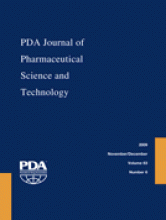Abstract
Seventy percent isopropyl alcohol (70% IPA) in water for injection is extensively utilised within pharmaceutical cleanrooms for glove and surface disinfection. When supplied in pressurised containers and delivered as an aerosol, it has been demonstrated that large quantities of 70% IPA particles are generated that remain airborne for substantial periods of time. Within non-unidirectional airflow cleanroom areas, such particles are likely to be recorded by the particle monitoring system. Consequently, the derived operational limits for particles will almost certainly be at “artificially high” levels and any particle generating activities with contamination potential may be masked. These high particle levels may not comply with the requirements of Annex 1 of the European Unions Guide to Good Manufacturing Practices (EU GGMP) and the United States Food and Drug Administration (FDA) Aseptic Processing Guideline. This is the case predominantly for the larger particles (≥5 μm), the monitoring of which is exclusively required by the Annex 1 guide. However, by using canisters that deliver the 70% IPA as a stream, large quantities of particles are not generated and more meaningful and compliant operational levels can be obtained. Additionally, the EU GGMP's Annex 1 continuing requirement to monitor particles ≥5 μm appears to have little value or scientific justification and restricts further harmonisation of the European guide with the US FDA Aseptic Processing Guideline.
- © PDA, Inc. 2009
PDA members receive access to all articles published in the current year and previous volume year. Institutional subscribers received access to all content. Log in below to receive access to this article if you are either of these.
If you are neither or you are a PDA member trying to access an article outside of your membership license, then you must purchase access to this article (below). If you do not have a username or password for JPST, you will be required to create an account prior to purchasing.
Full issue PDFs are for PDA members only.
Note to pda.org users
The PDA and PDA bookstore websites (www.pda.org and www.pda.org/bookstore) are separate websites from the PDA JPST website. When you first join PDA, your initial UserID and Password are sent to HighWirePress to create your PDA JPST account. Subsequent UserrID and Password changes required at the PDA websites will not pass on to PDA JPST and vice versa. If you forget your PDA JPST UserID and/or Password, you can request help to retrieve UserID and reset Password below.






